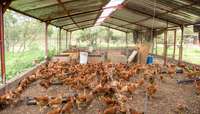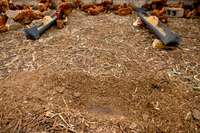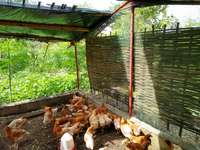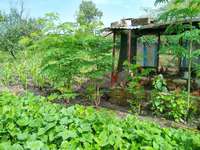Introduction

Figure 11. An 8x20 m deep litter coop operational in Senegal since 2017. Source: Noah Elhardt
The modern poultry industry has made huge strides in the efficiency and productivity of chicken operations, with hybrid broiler chickens reaching 2.26 kg (5lbs) in as little as five weeks (Hinsemu et al., 2018). To achieve this, genetics, temperature, humidity, light, biosecurity, and nutrients are all meticulously controlled, while potential diseases are preventatively controlled with antibiotics. These operations can be very profitable, but also smell bad and have significant environmental and health risks.
Many small-scale farmers in the tropics cannot control all the factors necessary for success with these types of operations. In Senegal, small flocks are routinely wiped out by disease, heat stress, or other complications. This article presents an alternative growing system originating in Korea utilizing a deep litter.
This system (Figure 11) prioritizes chicken health and robustness by attempting to recreate conditions natural to chickens. This system does not produce as much as industrial systems, but can be more profitable for small-scale farmers by reducing both risks and costs. It focuses on growing vigorous chickens with a balanced gut flora (microbial population) raised in healthy conditions, so that these chickens can ward off diseases themselves. Benefits and challenges encountered with the deep litter chicken system are listed in table 5.
| Benefits | Challenges |
|---|---|
|
Low building costs |
Sourcing organic litter material, especially in urban or arid areas, can be challenging. Modern fast-growing meat breeds like the ‘Cobb 500’ no longer possess the strength or instinct to scratch or dig in litter. Raising these breeds requires additional work to turn the litter. Does not produce as much as high-input systems |

Figure 12. Schematic drawing of chicken coop. Source: Noah Elhardt
Design attributes (Figure 12)
This deep litter coop design has three main distinctions from other coops: an organic layer as the floor of the coop, increased ventilation on all sides of the coop, and a gap in the roof. These three attributes help create a healthy environment for chickens to thrive.

Figure 13. A littler floor. In Senegal, we use wood chips, peanut shells, and millet chaff for our litter. Source: Noah Elhardt
Litter
The litter at the bottom of the entire coop structure should be at least 15 cm deep. Inadequate litter will become wet, compacted, and smell bad. You want to select a litter that is loose, dry, and high in carbon. It will combine with the nitrogen-rich chicken droppings to form a living compost turned by the chickens as they scratch in their litter. Options for litter materials include dried leaves, crushed peanut shells, crop residue, grasses, and sawdust (Figure 13).
A well-established litter teems with microbes, which rapidly break down manure and also outcompete disease organisms. You can immediately tell if a litter is healthy - a healthy litter smells like a forest floor! To accelerate the formation of a diverse and active microbial community in your litter, you can inoculate it with Indigenous Microorganisms (IMO). These can be cultured using inexpensive local materials such as rice bran or milk. We typically apply these when first establishing a litter, or if problems or smells arise later on. For more information, view ECHO’s resources about IMO [https://www.echocommunity.org/resources/tagged/Indigenous%20Microorganisms].
Chickens aerate and mix the litter by scratching as they look for food. Because the litter sits directly on the dirt ground, chickens also have access to the ground, allowing them dust baths and cooling. The reduction in cement costs is an additional benefit!
If you are in a dry climate, you may need to occasionally water the litter to keep the decomposition process going. After three to six months, litter materials turn into compost and can be used directly on crops.

Figure 14. Shade structure made from bamboo. This is often a good idea on one or two sides in these small coops to ensure shade availability in the mornings and late afternoons, and/or for wind protection. Source: Noah Elhardt
Ventilation
Both the chickens and their litter benefit from a continuous supply of cool, fresh air. Coop walls should be made to maximize ventilation. We typically make two to four of our coop walls out of wire mesh or another material that maximizes airflow while keeping chickens safe from predators. The bottom 30-60 cm consists of a short cement or brick wall that protects against predators such as dogs, snakes, or rats (Figures 14-15).
An opening in the center of the roof allows hot air to escape. This creates a convection current that draws in fresh air from the sides even when there is no wind.

Figure 15. This system can be scaled for profitable operations in a variety of settings. This 4x4m pen holds 80-100 birds. Source: Noah Elhardt
Sunlight
The opening in the roof also allows for sunlight to bake the litter floor throughout the day. Orient your coop so that, by sunset of each day, the entire coop floor will have received sunlight at some point. No other light or heat source is needed to keep the chickens warm or to stimulate egg production.
If your coop is small, the morning or evening sun streaming through the sides of the coop might cover the entire coop. If this is the case, you may want to add a shade structure similar to the one shown in figure 14 to provide the chickens with shade in at least part of the coop.
Roofing material, beam material, and bricks should be made with resources that are locally available. The roof in figure 14 is made from plastic tarp covered in grass thatch.
This design can be scaled to your needs for chicken production (Figure 15). We recommend a density of up to 5 birds per square meter.
Give chickens greens

Figure 16. In Senegal, we use forage grasses, leucaena, moringa, and weeds as our chicken greens. We plant foraging material close to the coop to make management and feeding easier. Source: Noah Elhardt
An important part of success for any poultry system is a healthy diet for the chickens. When chickens eat well, they have the energy and health to fight off diseases and to produce quality products (meat, eggs, and offspring). In particular, greens are an important and often overlooked part of the chicken’s natural diet. They are a critical part of this system in providing vitamins for the immune system as well as fiber for gut health. At the Beersheba Project, we feed 30-40 g of greens per chicken per day. Options for greens include grass, sweet potato leaves, moringa, katuk, chaya, weeds, and much more (Figure 16). For more information about incorporating greens and other local options into chicken feed, see “Cafeteria Feeding” of Chickens from EDN 97 (Peckham, 2007).
Conclusion
The deep litter system described here highlights the use of a simple, creative coop design to harness the benefits of naturally occurring resources —sunlight, air, and microbes— for long-term success in raising healthy chickens. Combine elements of structural design with healthy feed for best outcomes.
References
Hinsemu, F., Y. Hagos, Y. Tamiru, and A. Kebede. 2018. Review on Challenges and Opportunities of Poultry Breeds. Dairy and Vet Sci J. 7(2): 555706.
Peckham, G. 2007. “Cafeteria Feeding” of Chickens. ECHO Development Notes no. 97